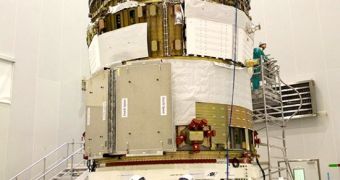After more than three weeks of delicate operations to load fuel onboard the Automated Transfer Vehicle Jules Verne, European engineers have also been successful in loading the precious oxygen cargo that will be delivered onboard the International Space Station. This represents the European Space Agency's first International Space Station resupply ship, and is scheduled to launch into space on February 22nd.
The loading phase that takes place in Europe's Spaceport in Kourou, French Guiana, began early this month and is conducted by a series of teams from Astrium, brought from Germany, UK and France. Special precautions had to be taken, in order to avoid contaminations that could determine an explosion, in case the pure oxygen gas leaked from the containers.
The first stage involved checking whether or not the ATV's gas tanks and its circuits were leakproof, after which engineers started loading oxygen. Such actions are standard procedure, knowing the extreme flammability of oxygen gas when in a pure state. Hydrocarbon particles had to be prevented from entering onboard the ATV, or to contaminate the ground equipment, as while in pure oxygen environments they can produce severe fires, or even explosions.
ESA officials state that now the oxygen loading phase is complete, and the crew can start loading the propellant onboard the Jules Verne vehicle. On top of the 20 kilograms of oxygen, the ATV will also receive 2,200 kilograms of Monomethylhydrazine fuel and 3,600 kilograms of Mixed Oxides of Nitrogen that represents the oxidizer for the propellant while in space. Another 860 kilograms of nitrogen tetroxide oxidizer and Unsymmetrical dimethylhydrazine have been stored onboard the Jules Verne ATV, in order to deliver it to the ISS, which will use it as fuel for altitude and orbit control maneuvers.
When the filling operation is completed, the ATV will contain about 6.5 tonnes of four different types of propellants, meaning the vehicle exceeds the 4-tonne limit imposed by Spaceport rules, which state that no other crew is allowed to work on other space vehicles in the perimeter of the S5 integration building.
Jules Verne will be put into Earth's orbit with the help of an Ariane 5 rocket and released, after which it will use its own propulsion system to steer itself towards the ISS. When fully loaded, it will weigh 19,4 tonnes, of which 1,338 kilograms of dry cargo. Due to safety precautions, all the electrical systems onboard the ATV Jules Verne are being deactivated during the loading stage.
Once it will dock, the crew of the ISS will release the full quantity of oxygen into the space station's atmosphere. Unlike some other resupply ships, that are being immediately dumped into Earth's atmosphere after being used, the Jules Verne will continue to remain attached to the ISS for as long as six months, in order to serve as a cargo compartment.

 14 DAY TRIAL //
14 DAY TRIAL //